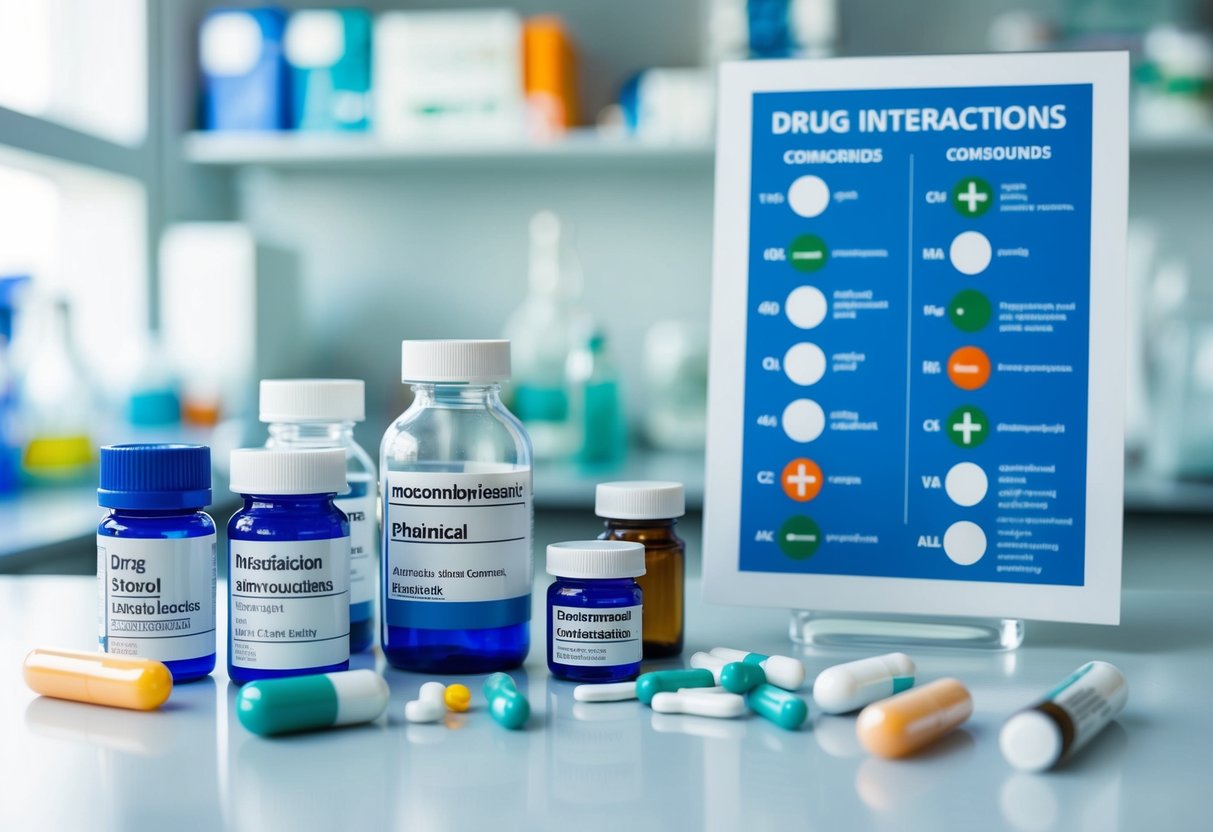Understanding Drug Interactions and Contraindications
Navigating the world of medications can often feel overwhelming, especially when considering drug interactions and contraindications. These terms refer to how drugs can interact with each other and with certain health conditions, potentially altering their effectiveness or causing harmful side effects. Understanding these interactions is crucial for safe medication use and avoiding adverse health effects.

Drug interactions can occur between medications, foods, or even due to specific health conditions. Knowing how two or more drugs might react when taken together is essential for anyone taking multiple medications. For example, certain drugs can either boost or reduce the effects of another, leading to either an overdose or inadequate treatment.
Contraindications are conditions or factors that increase the risk of using a particular drug. This might include specific diseases or other medications that should not be combined with the drug in question. Being informed helps ensure that medications are safe and effective.
Key Takeaways
- Drug interactions can affect medication effectiveness and safety.
- Contraindications involve conditions where drugs should not be used.
- Awareness and understanding can prevent adverse health issues.
Fundamentals of Pharmacodynamics
Pharmacodynamics explores how drugs influence the body. This involves the mechanisms of action and how drugs interact at the molecular level to produce effects. Understanding these principles is essential to predict drug interactions and enhance therapeutic outcomes.
Mechanisms of Drug Action
Drugs achieve their effects by binding to specific receptors in the body. This interaction can either stimulate the receptor (agonists) or block it (antagonists), modulating the biological response. The affinity a drug has for its receptor and its efficacy influence how well it can produce the desired effect.
For some drugs, the effect is achieved by influencing enzyme activity or altering cell membrane functions. For instance, some medications can inhibit enzymes responsible for breaking down neurotransmitters, thereby prolonging their action. Others may modify ion channel function, affecting cellular excitability. This receptor-drug interaction and pathway modulation are vital to understanding a drug’s effect on the body.
Principles of Drug Interactions
Drug interactions occur when one drug affects the action or metabolism of another. These can be additive, synergistic, or antagonistic. Additive interactions occur when the combined effect equals the sum of individual effects, while synergistic interactions result in an effect greater than the sum. Often, this is seen when two drugs target different sites in a pathway.
Antagonistic interactions happen when one drug reduces the effect of another. These interactions might occur at the receptor level, altering sensitivity or efficacy. Understanding these dynamics helps predict potential adverse effects and adjust dosages for safe and effective therapeutic regimes. Identifying such interactions is crucial for individualizing patient care and optimizing treatment efficacy.
Types of Drug Interactions
Drug interactions involve different mechanisms that affect how drugs work in the body. Understanding these types can help avoid unwanted effects.
Pharmacokinetic Interactions
Pharmacokinetic interactions occur when one drug changes how another drug is absorbed, distributed, metabolized, or excreted. This type affects the concentration of medication in the bloodstream. For example, some drugs may speed up or slow down the metabolism of another drug in the liver, causing either higher or lower levels of that drug in the blood. These interactions are crucial because they can lead to increased side effects or reduced drug efficacy.
Patients should be aware of substances that affect liver enzymes, such as certain antibiotics and anticonvulsants. This knowledge can prevent complications and help ensure that medications work as intended. Guidance from healthcare providers is vital in managing these interactions effectively.
Pharmacodynamic Interactions
Pharmacodynamic interactions occur when two drugs have additive, synergistic, or antagonistic effects at their target sites. These interactions don’t change drug concentrations but affect the drug’s overall effect on the body. An example is using two sedative drugs together, which can intensely increase sedation, impacting safety and alertness.
Some drugs may offset each other’s effects, such as combining a stimulant with a depressant. This can lead to an unpredictable response and requires careful monitoring. Understanding how drugs can modify each other’s actions helps in avoiding adverse effects and optimizing therapeutic outcomes.
Pharmaceutical Interactions
Pharmaceutical interactions, sometimes known as incompatibilities, happen before administration, often when mixing drugs in intravenous solutions. These interactions involve chemical or physical reactions that impact the stability or solubility of the drugs, leading to reduced efficacy or harmful byproducts.
For example, combining certain medications in a syringe or IV bag can lead to precipitation, reducing the drug’s effectiveness. Proper management of these interactions involves consulting compatibility charts or guidelines before preparation. Healthcare professionals play a key role in preventing pharmaceutical interactions to ensure safe medication administration.
Identifying Contraindications
Contraindications can prevent adverse effects when drugs or procedures are unsuitable for certain individuals. They can arise due to patient history, genetic factors, or specific properties of a drug. Understanding these elements is crucial for safe medication use and effective treatment planning.
Assessing Patient History
Assessing patient history is vital in identifying contraindications. Medical history can reveal past allergic reactions, chronic conditions, or past surgeries that might affect current drug choices. Including family history can provide additional insights into inherited conditions that may impact drug effectiveness or safety.
Patients should thoroughly discuss their medical background with healthcare providers. This discussion should cover all medications taken, including over-the-counter drugs and supplements. Keeping accurate records of medical visits and conditions enhances this process, promoting patient safety and effective care.
Genetic Considerations
Genetic considerations can play a major role in drug contraindications. Some individuals have genetic variations that affect drug metabolism, leading to potential adverse reactions. Pharmacogenomics—studying how genes affect drug response—helps identify these variations.
For example, genetic testing can reveal specific enzymes that process medications differently. Knowing these differences allows for personalized medication plans. Healthcare providers can select drugs that align better with a patient’s genetic profile, reducing the risk of harmful side effects or ineffective treatment.
Drug-Specific Contraindications
Drug-specific contraindications depend on the unique properties of a drug and its interactions with certain conditions. Some medications should never be used for conditions like pregnancy due to potential harm, such as isotretinoin, which can lead to serious birth defects if used during pregnancy (Drugs.com).
Checking medication labels and inserting screening protocols within healthcare systems can help identify such issues. Healthcare providers must stay informed and use tools like interaction checkers to ensure the right drug is prescribed for the right condition. This vigilance is critical in minimizing adverse effects and ensuring effective treatment.
Managing Drug Interactions and Contraindications
Managing drug interactions and contraindications requires evaluating the benefits and risks, adjusting dosages and schedules, and considering alternative treatments. Each approach helps ensure that medications provide the most benefit with the least risk.
Risk-Benefit Analysis
A risk-benefit analysis is essential in managing drug interactions and contraindications. Healthcare providers weigh the potential benefits of a medication against its risks, especially when interactions might occur. This process involves examining patient history, pre-existing conditions, and the therapeutic goals of the treatment.
Identifying interactions that pose significant risks helps in making informed decisions. For instance, certain drug combinations might increase the chance of adverse effects. In such cases, the risks may outweigh the potential benefits. It is crucial to evaluate each case individually.
Tools like interaction checkers can assist in identifying possible risks. They highlight potential dangers and guide healthcare providers in managing these risks effectively. These digital tools provide quick and detailed insights into possible interactions that may not be immediately obvious through observation alone.
Adjustment of Dosages and Timing
Adjusting the dosage or timing of medication is another strategy to manage interactions. Sometimes, simply changing when a drug is taken can minimize its interaction with another. This approach may involve staggering doses so that drugs are not in the system at the same time.
Healthcare professionals can change the dosage to reduce the intensity of an interaction. For example, if two medications have a cumulative effect, lowering the dose of one or both drugs can lessen potential side effects.
Monitoring the patient’s response is vital after any adjustment. Close observation helps ensure that the therapeutic effect of the drugs remains intact while reducing the chance of interactions. Frequent follow-ups allow for continual assessment and further adjustments as needed.
Alternative Therapeutic Options
When managing drug interactions and contraindications, considering alternative therapies is sometimes necessary. If potential risks of using two drugs together are too high, a different medication with similar therapeutic benefits might be chosen.
Alternative options also include non-drug therapies like lifestyle changes, physical therapy, or dietary adjustments. These options can reduce reliance on certain medications, thereby minimizing the risk of adverse interactions.
Selecting an alternative requires a comprehensive understanding of the patient’s overall health and treatment goals. The alternative must provide the intended therapeutic effect without introducing new risks. Hence, collaboration between healthcare teams is crucial to identifying and implementing appropriate alternatives.
Frequently Asked Questions
Drug interactions can greatly affect how medications work and may lead to harmful effects. Understanding these interactions and how to avoid them is crucial for anyone taking medication.
What are the most common types of drug interactions?
Drug interactions can occur when two or more drugs react with each other, which may change how one or both drugs function. They can involve prescription medications, over-the-counter drugs, or even dietary supplements.
Can you provide examples of drug-food interactions?
Certain foods can alter the way drugs are absorbed or metabolized. For instance, grapefruit juice affects how certain cholesterol-lowering drugs work, which can lead to increased drug levels in the bloodstream.
How can one check for potential drug-drug interactions?
Using online tools like WebMD’s Drug Interaction Checker can help identify potentially unsafe combinations. It’s also advised to consult with healthcare providers before combining medications.
What are some tips for learning about drug interactions effectively?
Effective learning about drug interactions involves regularly consulting with healthcare professionals, reading package inserts, and using reputable online resources for updates on any new interaction risks.
Which two commonly used drugs should not be taken together?
Mixing certain medications can be dangerous. A common example is the combination of certain blood thinners and NSAIDs, which can increase the risk of bleeding. Always check with a healthcare provider to ensure that any medications taken together are safe.
Conclusion
Understanding drug interactions and contraindications is crucial for safe medication use. These interactions, either pharmacokinetic (affecting drug absorption, metabolism, etc.) or pharmacodynamic (altering physiological functions), can impact a drug’s effectiveness and safety. Drug-nutrient interactions also matter, as medications can affect nutrient processing. Continuous education helps both healthcare providers and patients prevent adverse effects and ensure proper medication use.









